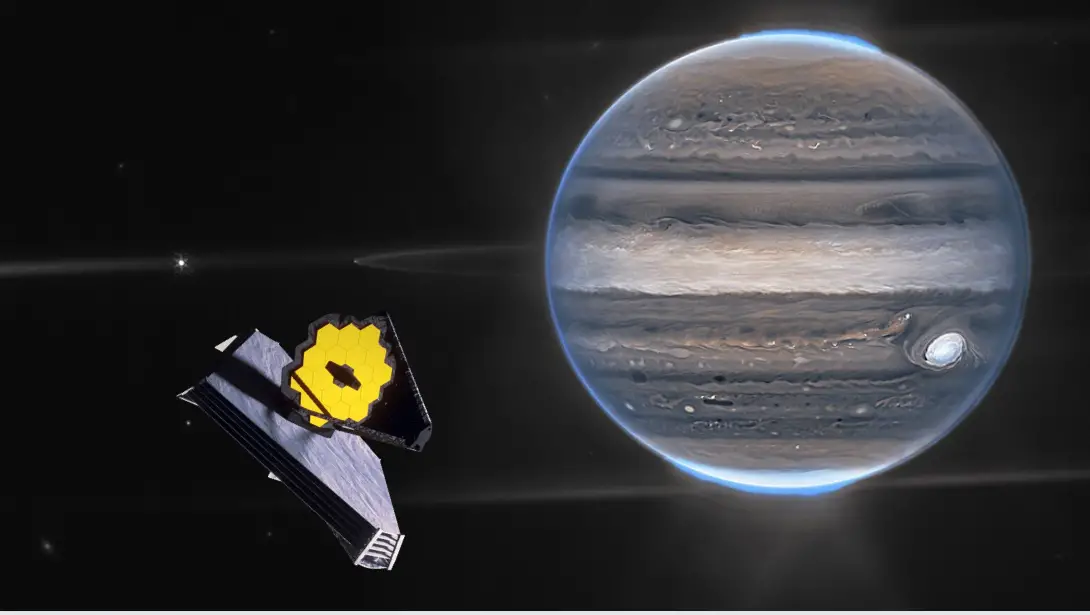The James Webb Space Telescope (JWST), which has been greatly anticipated, has already started making significant contributions to our understanding of the cosmos. The revolutionary telescope was put into operation on December 25, 2021, and it has since captivated the imaginations of both professional astronomers and amateur astronomers. The exploration of Jupiter, the largest planet in our solar system, has been a key highlight among its many other ambitious missions. Let’s look into the amazing findings that the James Webb Telescope has made about that majestic gas giant, shall we?
Explore Jupiter’s Complicated Atmosphere, Famous Storms, and Mysterious Great Red Spot with Unparalleled Determination and Accuracy One of the key goals of the JWST’s mission to Jupiter is to explore the planet’s complicated atmosphere, famous storms, and mysterious Great Red Spot. The telescope, which is loaded with cutting-edge infrared sensors, has supplied researchers with views that have never been seen before, illuminating particulars that could not be seen by any other device.
The initial results of the James Webb Telescope on Jupiter’s atmosphere have been nothing short of stunning, both in terms of the images it has captured and the dynamics of its atmosphere. It has uncovered intricate cloud patterns, atmospheric features, and the interaction of various gases on the planet by obtaining high-resolution photos in the infrared range. The observations made by the telescope have provided information on the dynamic weather patterns, including the violent storms, atmospheric bands, and jet streams that the planet experiences.
Exploration of the Great Red Spot The Great Red Spot, a monstrous storm that has been raging on Jupiter for ages, has been a topic of intense interest for scientists. The James Webb Telescope, with its sophisticated instruments, has conducted in-depth research on this recognizable characteristic. The observations made with the telescope have provided us with fresh information regarding the structure, evolution, and behavior of the Great Red Spot, which contributes to our comprehension of the mechanisms that contribute to its longevity.
Examining Jupiter’s Satellites In addition to researching Jupiter itself, the James Webb Space Telescope (JWST) has also been looking at the mysterious moons that orbit Jupiter. The possibility that one of Jupiter’s largest moons, Europa, could have a subsurface ocean has long been one of the moon’s most intriguing features for astronomers. The telescope’s investigation of the moon’s thermal emissions has provided significant new information regarding the possible presence of an ocean beneath Europa’s icy crust and its chemical make-up. This information lays the groundwork for future research and the investigation into whether or if there is life outside in our solar system.
Mapping Jupiter’s Magnetic Field The James Webb Telescope has played an important role in mapping Jupiter’s magnetic field and shedding light on the mysteries surrounding Jupiter’s magnetic field. The telescope has provided essential insights into the dynamic interactions between the magnetic field and the atmosphere of the planet by measuring the auroras of the planet in ultraviolet light. These observations contribute to a deeper comprehension of the intricate relationship that exists between Jupiter’s magnetosphere and the environment that surrounds it.
Implications for Future Exploration The findings that the James Webb Telescope uncovered about Jupiter have enormous repercussions for our comprehension of planetary systems and the possibility of life existing in places other than Earth. The knowledge obtained from this mission will serve as a basis for future space exploration activities and will shape the design and execution of future missions to conduct a more in-depth examination of Jupiter and its moons.
The James Webb Telescope has already made significant gains toward solving the mysteries of Jupiter. It has revealed startling details about the atmosphere of the planet, as well as its famous storms and other mysterious aspects. Due to the remarkable resolution of the telescope as well as its cutting-edge instruments, researchers have been granted vistas that have never been seen before as well as a greater knowledge of this spectacular gas giant. As the JWST continues its mission, we look forward with great anticipation to new discoveries that will definitely broaden our understanding of Jupiter and the fascinating system it inhabits.
![]()
